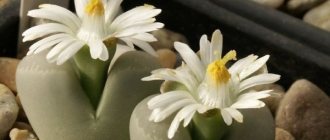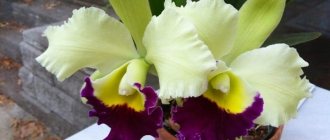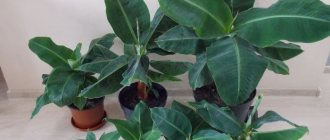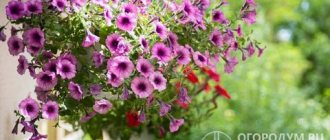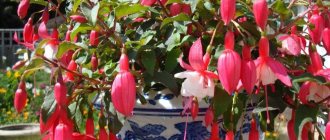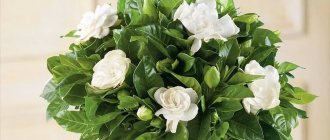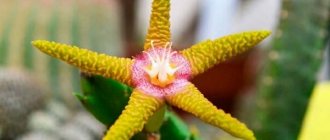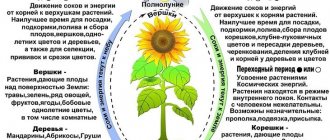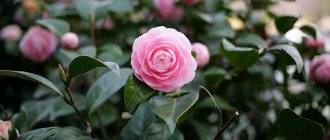Aeonium is an unusually ornamental plant that does not require special care, which, oddly enough, quite rarely decorates the window sills of city apartments.
The rosette formed by large fleshy leaves resembles a large fantastic flower , surpassing in beauty a real bud.
Such a “flower” delights its owners all the time, without the risk of crumbling.
General description of succulents of the genus Aeonium
Representatives of the genus Aeonium are succulent crops with long curved stems and almost perfect rosettes of leaves. Visually it may seem that these are not real, but artificial plants.
Photo of Eonimum in natural conditions
Aeoniums form fleshy rosettes that grow 5-60 centimeters in height. The diameter of the leaves is up to 60 centimeters. They have a round shape. The stems can be both short and long, sometimes branched. The shade of the leaves is different - there are solid colors or variegated ones - with white, yellow, red or green splashes.
New leaves actively develop every year. The lower leaves die off, and the stem, in turn, lengthens. The root system of Aeonium is branched. Thread-shaped roots appear at the places where the leaves are attached to the stems.
Flowers are formed from the middle of the rosettes. Visually, they are very small, resemble stars, and create groups. Most varieties bloom at the end of winter or at the beginning of summer. The crops can be either purely low-growing or branching, creating original bushes.
Most Aeonium representatives can withstand frosts down to -4 degrees, but there are also varieties that cannot withstand low temperatures.
Temperature
Ornamental grass, accustomed to different temperature conditions, will feel comfortable at room temperature. In summer, you should maintain a temperature not exceeding 25 °C. In winter, you need to ensure that the air in the room does not fall below 10 °C.
Attention! In summer, the flower can be kept on the street or veranda. Fresh air will have a beneficial effect on the plant and give it a more intense color.
Key points in caring for the Aeonium succulent at home
These succulent plants do not require much care from you. You just need to adhere to certain conditions in growing these colorful flowers.
Photo of Aeonium grown in the garden
What soil is suitable for Aeonium?
Like other succulent plants, Aeoniums need well-draining soil. Use cactus potting mix in combination with perlite for extra drainage at a ratio of about 1 to 1. Other gardeners recommend using sandy soil by mixing cactus potting mix with coarse sand (about a 2 to 1 ratio). A mixture of regular soil, coarse sand, perlite or pumice will also work. If you grow them in pots, repot them every 2-3 years in fresh soil.
Temperature
For Canarian succulents during the growing season, the acceptable temperature range is +20…25 °C. However, plants do not like frost and very high temperatures.
Remember! Aeoniums have a growing season from autumn to spring. In summer they remain dormant.
Watering the Aeoniums
Succulents of the genus Aeonium do not require abundant watering. Water them every five to ten days. But in case of prolonged heat, you need to water more often. On the other hand, too much moisture can be a problem for some species.
A good way to check if it's time to water is to check the soil moisture. It is best to water only after the soil in the pot has dried 1/3 of the way. In winter, moisture is limited and carried out only after the leaves begin to lose turgor.
Information about other succulents
Kalanchoe Blossfeld variety 'Kalandiva'
Crassula or Crassula: features of the genus Crassula
Features of the Agave succulent genus and how to grow them
Fertilizer
Feed during the growing season with a balanced, half-strength fertilizer approximately once a month. You can use a slow-release granular fertilizer with a minimal amount of nitrogen. Do not feed while at rest.
Lighting
Aeoniums require at least six hours of sunlight to fully color their leaves. Provide as much light as possible, but with some shade during hot summers. If you notice that the plant is stretching, it means that the plant is not receiving enough light and is reaching towards the sun. Move the plant to a brighter area.
Photo of Aeonium, who received burns due to prolonged exposure to the sun
On the other hand, if your Aeonium is exposed to direct sunlight for too long in the summer, it will most likely get burned. Try to limit the time the flower is exposed to sunlight in the summer. For the optimal amount of light received, it is better to choose windows facing east or west. If you can't provide enough light during the winter or have long, dark winters, consider using a grow light.
How to care for Aeonium during dormancy
Succulents go dormant during the summer in very hot, dry weather, especially when left outside in the summer heat. When you see that your Aeoniums are dropping a lot of their lower leaves, the stems will appear bare and unkempt and it may look like the plant is dying, but in reality it is just going through a dormant period. Succulents shed their leaves when they are dormant.
Don't expect too much activity or growth from the Aeoniums during this period. During this time, leave the plant alone and do not stress the plant by cutting stems, repotting or propagating the plant. You can continue to water the plant as usual. Refrain from overwatering and refrain from fertilizing during the dormant season.
Aeonium pruning
After flowering, the rosette of Aeonium dies, releasing a peduncle. It is necessary to trim the flower stalks of the plant along with the dried rosettes.
This video shows the process of pruning faded flower stalks of Eonimum with expert advice
Illumination
"Desert Rose" is a light-loving plant. Therefore, it is better to keep the plant on the south or south-east side of the windows. Since the flower loves light, there is no need to remove it on hot days. Only during the hottest hours can you slightly shade the succulent so that the plant does not get burned.
In the winter season, the flower should be placed in the brightest, most illuminated place.
“Desert Rose” is capricious and does not perceive artificial light. A lack of sunlight may not have the best effect on the plant: the leaves will begin to fade, become smaller and the plant will lose its attractiveness and decorativeness.
Common pests of Aeoniums
Aeoniums are not immune to pests, which sometimes attack succulents, especially when they are outdoors. Fortunately, they are tough and hardy plants that can cope with almost anything, even severe infestations. A few common pests that can damage Aeonium are:
Aphid
These are small insects with a thick, teardrop-shaped body. They may suck leaves or flowers at the ends of stems, especially on the underside of the plant's foliage.
How to deal with aphids : treat the plant with a mixture of soapy water. Add a few drops of dish soap to 1-2 cups of water and mix well. Spray on infected areas and the undersides of leaves. You can also add 1 teaspoon of vegetable oil to soapy water and mix well. Spray on infested areas where you see insects. If necessary, repeat the treatment about once a week until the problem goes away.
Mealybugs
The Aeonium succulent is particularly susceptible to mealybugs. They are tiny and very easy to miss. An early sign that your plants have mealybugs is the white cottony growths you see on your plants. Mealybugs are slow moving insects and can be easily identified and removed. You can usually spot them on the leaves or undersides of leaves, and between the joints of the plant.
How to remove mealybugs : Use a cotton swab or Q-tip dipped in rubbing alcohol and apply it directly to the bugs and anywhere you see the white cottony substance. Alternatively, you can use a spray bottle and spray rubbing alcohol directly onto the bugs and white fuzz. You can also dilute the alcohol by about half with water.
Instead of alcohol, you can also use soap, such as dish soap, diluted with water.
If necessary, repeat the treatment about once a week until the problem goes away. Isolate the infested plant to avoid infecting other plants, as mealy bugs can easily spread from plant to plant.
You can learn more about Aeoniums and their care from this video
Transfer
A young “desert rose” should be replanted once a year. An adult plant needs to be replanted once every two to three years, and that’s because the root system grows so much that it becomes cramped in the pot. To replant, you need to prepare a new pot and fill its bottom with a drainage layer. The flower must be carefully removed from the old pot along with the root system and a lump of earth and placed in a new pot. Fill the resulting voids with soil mixture.
There is no need to water the bush after replanting.
How can you propagate the Aeonium succulent?
Most species of succulents of the genus Aeonium are monocarpic (they die after flowering). If the plant has side shoots, the plant continues to live. Otherwise, the entire plant will die. This is why you need to periodically plant new plants from cuttings. Any Aeonium succulent reproduces in three ways - seed, leaf and cuttings.
Propagation of succulents by seeds
The seed method consists of scattering seeds over the surface of the soil, without immersing them deeply. The container is systematically ventilated, and the planted seed is sprayed. To ensure successful seed germination, create greenhouse conditions by covering the container with glass. The optimal temperature for such a process is considered to be +20 degrees.
Propagation of Aeonium by cuttings
The second method is succulent cuttings. To do this, the stem with the rosette is cut 5 cm lower than the rosette itself. The cut must be processed using crushed activated carbon.
Photos of Aeonium cuttings
In the container where the fresh seedling will grow, be sure to add a sand mixture with leaf soil (ratio - 2 to 1). Afterwards, the Aeonium cuttings are planted and rooted. A prerequisite is soil moisture. The formation of roots can be observed after 15-20 days.
Reproduction by leaves
Leaf propagation involves preparing several leaves. Carefully tearing off several leaves, drying them for at least 2-3 hours, after which they are laid out on the surface of the soil. It is necessary to systematically spray the surface so that the soil remains slightly moist. After a certain time, roots and later young rosettes will begin to form at the top. After they grow up, transplanting into separate pots is allowed.
Worth knowing! Most Aeoniums have thin leaves and little pulp. Because of this, the succulent often does not have time to grow roots and form a rosette before the leaf dries out. If you decide to propagate Aeonium using this method, you need to use as many thick leaves as possible to increase the chance of seeing a young plant.
Main species of the genus Aeonium
There are more than 35 varieties of these crops; let’s look at the most popular ones.
Aeonium arboreum
This is a succulent crop, has a small branching, up to 2 meters in height (in natural conditions). The diameter of the stems is up to 3 centimeters. The leaves reach a length of up to 15 centimeters and a width of up to 5 centimeters.
Photo of Aeonium arboreum
In different varieties, the foliage color can range from glossy green to black. The flowers are bright yellow, up to 2 centimeters in diameter, blooming at the end of winter.
Aeonium nobile
A little-known species, but very beautiful. Characterized by its large size. Large fleshy leaves form a rosette up to 60 cm in size.
Photo of Aeonium nobile
Of all the variety of Aeoniums, this species has the most beautiful flowers, complementing the succulent reddish leaves.
Haworth's Aeonium (Aeonium haworthii 'Dream Color') or Aeonium 'Kiwi'
Shrubby succulent with large branching. It reaches a height of up to 50 cm. Of all the hybrids, Aeonium Kiwi stands out for its incredibly luscious foliage.
Their color is light green, but with a slight grayish tint. The center of the rosette is rich green in color. Quite easy to care for.
Aeonium canariense
The birthplace of culture is the island of Tenerife. Forms beautiful dense leaf rosettes, very close to the ground.
Aeonium canariense
The petals are painted yellow, their height is up to 70 centimeters.
Aeonium balsamiferum
A shrub with dense, thick leaves and a sinuous shape. Shoots are branched.
Aeonium Balsamiferum
The rosettes are painted in a light green shade, visually reminiscent of roses. The leaves are pointed, quite fleshy and dense. Blooms with a golden yellow hue.
Aeonium Tabuliforme
Prefers moist soils in natural conditions. The leaves are fleshy, hairy, and dark green in color.
Aeonium Tabuliforme
It is grown as a perennial or annual plant.
Aeonium virgineum
It has practically no stems. It forms many loose leaf rosettes. This allows the culture to grow quite widely.
Aeonium virgineum
The leaf blade is light green in color, but with a pinkish tint. Under natural conditions, the crop can grow up to 100 cm. The color of the flowers is yellowish.
Aeonium lindleyi
The height of this variety is up to 50 centimeters. This is a multi-stemmed plant. Rosettes up to 9 centimeters form on the stems; they are supported by juicy, thick leaves.
Aeonium lindleyi
Their surface is sticky, with slight pubescence. The flowers are small, yellow in color, forming panicles.
Signs and superstitions about the Aeonium succulent
All varieties of this genus are non-toxic and do not emit harmful substances. Therefore, flowerpots are placed in any room. According to Feng Shui, such flowers symbolize prosperity and long life in the home. It is believed that representatives of the genus are capable of not only organically complementing the interior, but also increasing the internal strength of the residents of the house. Those who want to attract finance, love and health to their apartment are recommended to keep such flowers at home.
Indoor flower Aeonium looks good as a bonsai. It is easy to trim. Knowing all the nuances and rules of how and when to prune, you can create original plant shapes.
Separately, the healing properties of Aeoniums should be mentioned. Plant juice is actively used for herpes, inflammatory processes, and abscesses. It contains many antiseptic substances that destroy various types of bacteria. The juice is also used to treat itching, burns and abrasions.
Useful video
Watch the video with important tips for growing succulents:
In addition to the variety of species, colors and shapes, aeoniums are hypoallergenic and do not emit harmful substances into the air. Unpretentious succulents are suitable for decorating south-eastern windows of bedrooms and children's rooms.
READ ABOUT OTHER SUCCULENTS: GASTERIA, COTYLEDON, GRASSWAY, LITHOPS, REJUVEN, SEDUM, a href=”https://botanicoved.com/komnatnye/sukkulenty/raznovidnosti-sukkulenty/pahifitum.html” rel=”noopener” target=”_blank ”>PACHYPHYTUUM, PORTULACARIA, SEDEVERIA, STAPELIA, HAWORTIA, ECHEVERIA.
